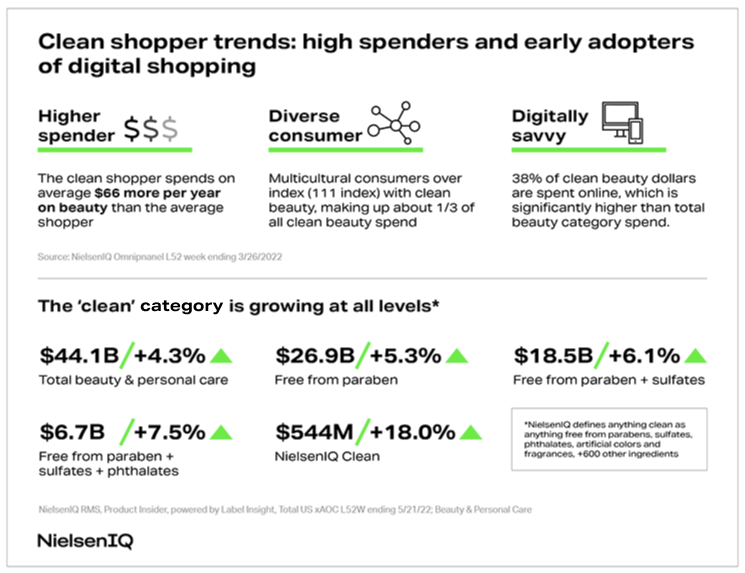Growth in clean beauty
When the “clean beauty” movement began, its focus was primarily on identifying cleaner formulations of products which were free from common harmful ingredients such as parabens, sulfates, and phthalates. As consumers have evolved and become more knowledgeable, they are increasingly demanding that the products they buy also be sustainable, which encompasses a range of concerns, like certified fair trade or vegan, biodegradable packaging, or plastic-free.
Shoppers are not just saying they want clean products, they are shopping that way too. As of May 2022, products that meet the NielsenIQ Clean definition saw growth of +18%, vs 4.3% growth across the entire beauty and personal care category. Shoppers are looking for specific claims as well, with paraben free beauty products now making up over 60% of total beauty and personal care sales and growing at 5.3%.
The “free-from” ingredient trends have sustained over several years, and claims like paraben free, sulfate free, and phthalate free now make up a significant portion of the market and are slightly outpacing total category growth. However, the real sales growth is coming from the ethical and sustainability trends. Interest in beauty and personal care products that are vegan, humane, reef safe, free from plastic, and free from artificial fragrances are all experiencing strong growth and could be inching toward mainstream adoption. Consumers are actively seeking out long-term sustainable solutions as well as products that do no harm.
What’s working in clean?
While we know that know that a lot of customers are looking for products that fall under the “clean” umbrella, defining “clean” can get a bit tricky as there are so many different attributes and ingredients to consider. Retailers have taken the opportunity to step up and organize their clean products to make them accessible to customers.
Specialty beauty retailers have found success by labeling products with a recognizable icon if it adheres to their definition of clean. For example, Ulta’s “Conscious Beauty” program highlights products with attributes like vegan or cruelty-free, and that have sustainable packaging, clean ingredients, or a positive impact on the planet. Sephora designates products as either “clean” or “clean + planet positive” under its “Clean at Sephora” program. On the mass beauty side, Target has developed a “Target Clean” icon on products free from unwanted ingredients, as well as a “Target Zero” icon on products and packaging designed to reduce waste.
E-com powers clean product sales
Emerging brands need to be paying attention to who’s buying clean, where they’re buying it, and why. NielsenIQ data has found that consumers looking for clean products tend to be high spenders and early adopters of digital shopping – the clean shopper spends on average $66 more per year on beauty, and 38% of clean beauty dollars are spent online.
Clean beauty products and brands have been thriving online during the pandemic, because e-commerce makes it easy to filter products by desired attributes, read product ingredients, and research brand and retailer commitments to health and sustainability.
According to NielsenIQ Omnishopper Fundamentals data, 23% of online beauty and personal care consumers say detailed product information drives them to shop online, and 13% of beauty and personal care consumers are actively looking for products that are environmentally friendly when they shop.

Don’t get caught greenwashing
Today’s consumers expect products to be made with less plastic and less waste and more environmentally friendly with renewable energy and regenerative agriculture. The NielsenIQ Leading Edge report showed a 51% of consumers want to try brands committed to reducing the amount of plastic in their packaging, and a 33% have already tried products with reduced plastic.
Clean beauty customers also want to see ingredients they recognize and trust, and that’s increasingly coming from grocery aisles. Ingredients like pineapple, celery, algae, and rice are showing up more often in skin care, beauty, and hair care products.
However, consumers aren’t satisfied only with popular ingredients or attribute claims on labels. The public is now more discerning of the products they choose, and they don’t want to see companies “greenwashing” just to capitalize on the trend. Consumers expect real commitment and transparency from brands before they make a purchase decision.





